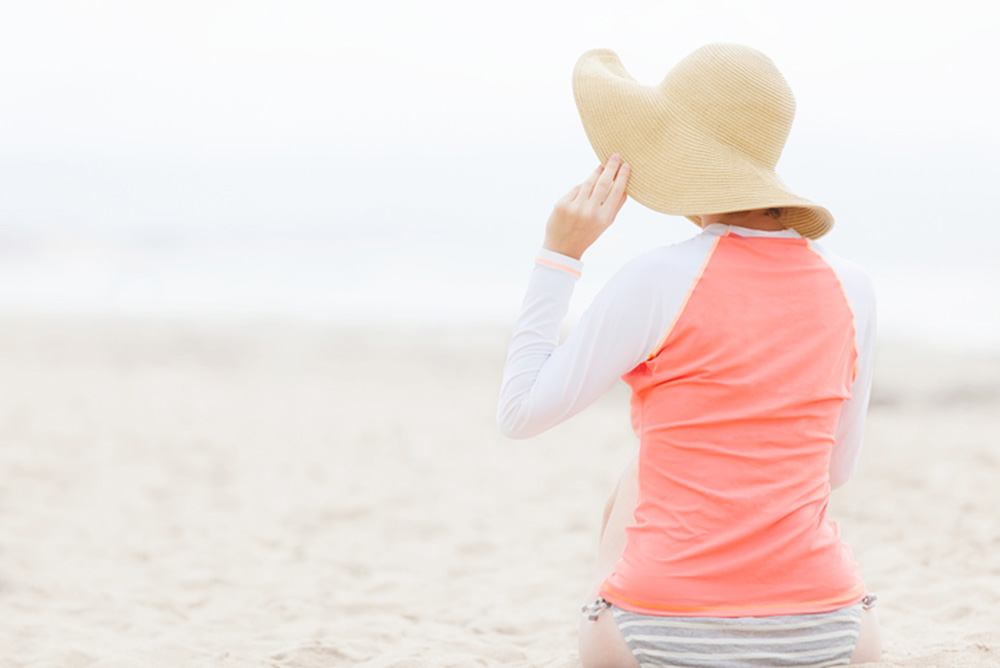
iStock
BY SUMMER’S END, even with the best protection, your skin may have simply had too much sun. Sunscreens aren’t always up to snuff, mostly because people generally put on one-third to one-half of the very thick application used for establishing SPF and then fail to reapply as often as advised.
Hovering in the shade is unreliable, because UV light reflects off surfaces and sunlight is more scattered on cloudy days. And those nasty UV rays can reach below the water’s surface and even penetrate glass windows.
Short of staying indoors for the prime sun hours between 10am and 4pm, the right clothes can help—and they can’t be applied incorrectly: compared to sunscreen, a shirt is either on or off. But while dark-colored jeans offer excellent protection, a white T-shirt falls near the bottom of the list —even lower when wet or worn.
The most important variable is coverage: the more skin covered, the better—long sleeves, long pants, wide-brimmed hat and wrap-around sunglasses, according to the Skin Cancer Foundation (SCF).
UPF (ultraviolet protection factor) is like SPF but for clothes; it measures the amount of UV radiation that penetrates fabric and reaches the skin. While UPF refers to the burning ultraviolet B rays, a shirt that blocks UVB will also block most UVA, while a high-SPF sunscreen filters only UVB, unless labeled broad-spectrum. (UVA rays are linked to skin cancers.)
A UPF rating of 50 means 1/50th or 2% of the sun’s UV rays get through to the skin. Most cotton T-shirts have a UPF of 7 for white—down to 3 when wet—and 10 for darker colors. Indigo denim jeans clock in at 1,700—a complete block.
To win the SCF’s Seal of Recommendation, fabric must have a minimum UPF of 30. While a UPF of 30-49 offers “very good protection,” 50+ is “excellent.” Fabrics that are light colored, lightweight and loosely woven give the worst protection, and sun protection is reduced when clothing is tight or stretched out, if it becomes damp or wet, or after it’s been worn and washed too many times.
For fabric choices, the “most important single protective factor of fabrics is…weave density – i.e., how much of the fabric is actually fiber and how much is open space, through which UVR can pass,” according to the SCF. The tighter the knit or weave, the smaller the holes and the less UVR can get through.
Studies done in Australia found lycra/elastane fabrics were the most likely to have UPFs of 50 or higher, followed by plastic, nylon and polyester. And REI’s Expert Advice page advises that “Cotton, rayon, flax and hemp fabrics often score low without added treatments.”
On the other hand, unbleached cotton and linens can act as “high absorbers.” And even thin satiny silks can be highly protective, like high-luster polyesters, because they reflect radiation, according to the SCF.
Protective design features include high neck coverage; longer sleeves; and a double layer of fabric at the shoulders, a high UVR exposure area. Hats made of tightly woven fabric are better than canvas or straw, and a brim wider than 2-3 inches is advised—especially compared to the narrow protection afforded from baseball caps.
Darker colors are more protective because they absorb more UV rays. Dark blues are best, reds are good and yellows the worst, leading to the advice: go for loud. Experts suggest darker-colored clothing as a significant factor in protection, also as lower-priced options compared to specially labeled sun-protective fabrics.
“Clothing should be your first choice for reducing UV exposure,” states the Environmental working Group. “For everyday use, most clothing without a UPF label can provide adequate sun protection.”
New Jersey dermatologist Naomi Lawrence agrees, telling the New York Times: “When it comes to sun protection, you really can’t beat a dark shirt with a tight weave and a good hat.”
Clothing can also be made sun-protective by adding sunscreen chemicals, such as tinosorb, titanium dioxide and zinc oxide. An alternative is “washing” similar chemicals into clothing. SunGuard contains tinosorb, which lasts through dozens of washings. The Environmental Working Group advises against wearing chemically treated clothes.
High-tech clothing offers sun protection up to 50+, but it can be impossible to find out whether an item has been treated with chemical sunscreens or if it instead relies on fabrics of protective weave and colors and/or designs offering good coverage. (Investigating one REI item with a high sun-protection rating failed to turn up any relevant information.) Meanwhile, options are proliferating: Amazon’s sun-protective products number close to 25,000 and include a wide assortment of clothes.
For swimmers, rashguards improve every day, with the full-zip models easiest to put on and take off. To be reliably protective, the UPF for these should be 50+ because UPF decreases when wet.
As with sunscreens, though, experts worry about high-UPF attire creating a false sense of security. The best advice—even when applying sunscreen and wearing protective clothing: keep an eye on the clock to minimize exposure during the hours of strong sunlight.
Every Tuesday in this space, well-being editor Mary Carpenter fills us in on the latest health news.
